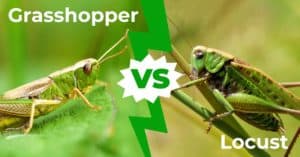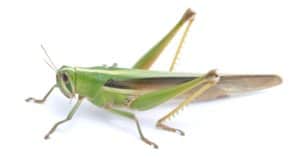Black and yellow grasshoppers you find in the United States are Eastern Lubber Grasshoppers. This species is found mostly in the southeastern region of the United States. They’re found in Florida, South Carolina, Georgia, Alabama, Mississippi, North Carolina, Alabama, Louisiana, and central Texas.
However, if you spot one of these grasshoppers, you shouldn’t touch it. When threatened, these grasshoppers make a loud hissing noise and give off a foul-smelling spray. They cannot fly, so they must defend themselves in other ways.
Unlike most grasshoppers, this one is quite clumsy and moves very slowly. It travels mostly by walking – not jumping like you may imagine a grasshopper to do.
So, What is the Eastern Lubber Grasshopper?
The Eastern Lubber Grasshopper is one of the unique grasshoppers in their native range. Adults tend to be very colorful, but their pattern varies widely. For the most part, they’re yellow or tan. They have a black portion on their antennae and abdominal area. They do have wings that are almost as long as their body. However, they cannot use them.
Darker forms of the species exist, though, especially in northern Florida. Some of these grasshoppers are completely black, which can make identification challenging. Adults are larger than most grasshoppers, ranging from 55 to 90 mm. Due to their larger size, they don’t leap very well, either. They mostly walk around, making very small jumps when frightened.
They are good at climbing, though. You may find them climbing trees and on the tips of branches.
Both sexes can make noises by rubbing their wings together. They can also spread their wings and release a foul-smelling foam that puts off predators. Don’t pick them up, or you’ll be a target. This foam can vary depending on the grasshopper’s diet, so predators can’t adapt to it.
Their bright coloration is thought to be a warning to predators that they aren’t palatable.
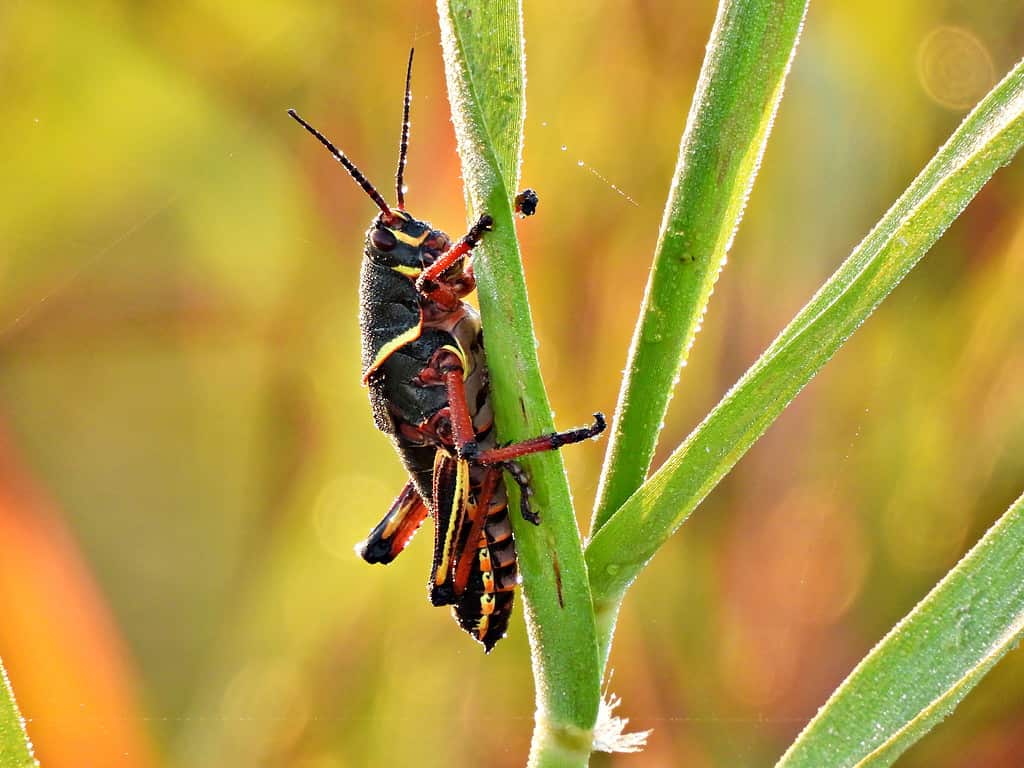
The Eastern Lubber grasshopper is very good at climbing.
©iStock.com/passion4nature
Life Cycle
Adults of this species live for one year. Eggs don’t hatch through the winter. However, they don’t lay dormant, technically. Instead, they have a very long development period of up to 200 days at low winter temperatures.
While adults die after only a few months in northern regions, they can live for quite a long time in southern Florida. Either way, eggs are produced about a month after the adults mature. Females will begin laying eggs when spring hits. Males typically guard the females between breeding and egg laying for about a day.
To lay eggs, the female finds a sunny area of a higher elevation. They lay their eggs in a small patch of soil that they find suitable. Usually, this hole is fairly shallow, but the depth does vary a bit. The eggs are deposited with a foamy froth.
The eggs develop in the hole through the late fall and winter until they hatch in the spring. The young grasshoppers climb out of the soil after they hatch and then eat whatever nearby food is available.
You can find these grasshoppers in damp areas, but they usually move to drier areas for egg-laying.
The natural predator of these grasshoppers aren’t widely known, and sadly, no studies have been done on this topic. Birds and lizards avoid this grasshopper because of the toxic secretions they produce. However, younger birds and lizards may consume them, gag, regurgitate, and sometimes die after consuming them.
However, loggerhead shrikes have gotten around this toxin by impaling the grasshoppers onto barbed wire fences and then waiting two to three days for the toxins to degrade.
These grasshoppers are prone to several parasites.
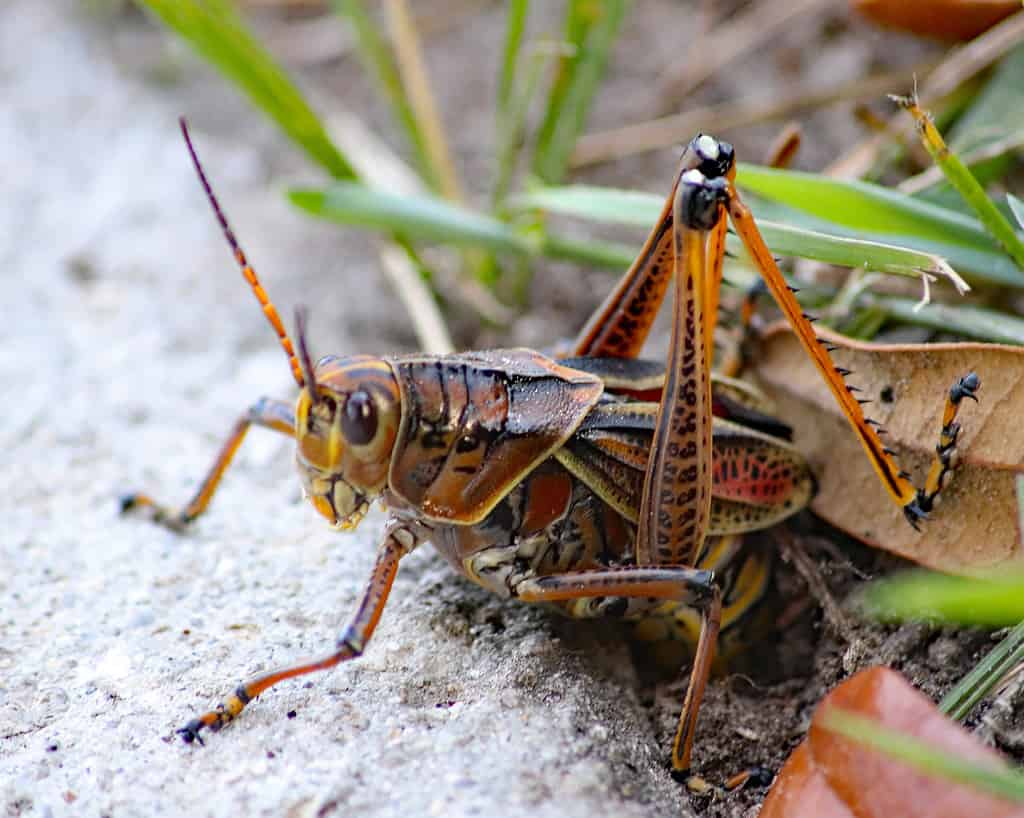
The eastern lubber grasshopper’s eggs have a long development period of up to 200 days at low winter temperatures until they hatch in spring.
©iStock.com/jrubacha
Habitats
These grasshoppers have a wide range and eat just about any plant, including herbs, weeds, grasses, and shrubs. However, they’re most adapted to feeding on broad-leafed plants and may feed on other less effectively.
They prefer to live in wetter areas. However, they lay eggs and hatch in drier areas. This means they must leave the original area to find a wetter place. Because they’re flightless, their migrations are long and put them into contact with many vegetables and crops. Therefore, they’re considered pests in many areas.
They damage peanuts, corn, citrus, figs, peaches, and ornamental plants.
While they can eat just about anything, they prefer certain plants. They seem to strongly prefer vegetable plants, including peas and lettuce. They may also eat tomatoes, pepper, okra, and sweet corn, but these are less preferred. The grasshoppers can defoliate plants, so they are often considered a pest.
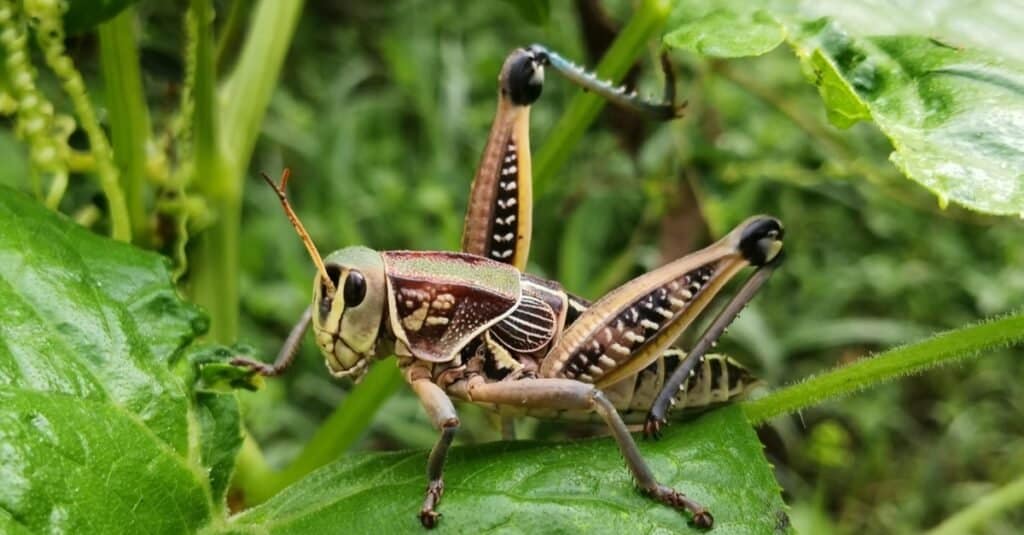
The Eastern lubber grasshopper will eat just about any plant, including vegetables, herbs, weeds, grasses, and shrubs.
©NEFS/Shutterstock.com
Damage and Management
Because these grasshoppers defoliate whole plants, they can cause serious problems for farmers (and even your average homeowner). They can strip the foliage from plants because they tend to stick together.
These grasshoppers will also eat holes through the vegetation and then move onto another leaf. Of course, this also damages the plant.
While they are extremely big, they don’t eat much more than smaller grasshoppers. Therefore, their large size isn’t much of a problem.
Damage occurs most often in areas with tall weeds or semi-aquatic plants. The edges of ponds and other wet areas attract the grasshoppers. However, once the grasshoppers set up shop in one of these areas, they spread out to farmland and neighborhoods, causing crop damage.
Therefore, keeping tabs on their population in the wetter areas is often important, even though there may not be any important crops here. If they begin to overflow from their natural food sources, they may move on to farmers’ crops.
Management can include physically removing the insects from the plants when possible. However, when there are many grasshoppers, insecticides are typically recommended. Due to their large size, these grasshoppers are often hard to eliminate. Spraying the plants is often ineffective. Instead, you must spray the grasshoppers themselves (which still doesn’t work sometimes).
It may take a few days to see results, as well.
Younger grasshoppers are often more susceptible to insecticides. Therefore, many farmers treat the areas around their fields to prevent younger grasshoppers from setting up shop there and later moving on to their crops.
Because these grasshoppers tend to migrate in mass, they may continue invading an area even after treatment. Protecting plants can be extremely challenging.

Because these grasshoppers defoliate whole plants, they can cause serious problems for farmers.
©iStock.com/passion4nature
The photo featured at the top of this post is © iStock.com/passion4nature
Thank you for reading! Have some feedback for us? Contact the AZ Animals editorial team.




